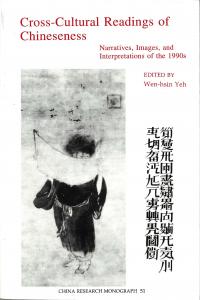Cross-Cultural Readings of Chineseness
Cross-Cultural Readings of Chineseness
Wen-hsin Yeh, ed.
The six essays in this volume offer interpretive readings of a film, a work of plastic art, and an essay, all products of contemporary China. The works are "Chinese" not just because they are by Chinese artists and writers and "from China" but also because they bear witness to cultural and intellectual imaginations by the Chinese themselves and about China in an era of border-crossing. They are part of an interactive reconstruction of the meaning of "Chineseness" in our time.
As a nonprofit academic press, we need your support to publish our books. Your gift can help us make more of our titles available as e-books. DONATE NOW
Title information
The contributors offer interpretive readings of a film, a work of plastic art, and an essay, all products of contemporary China. The works are "Chinese" not just because they are by Chinese artists and writers and "from China" but also because they bear witness to cultural and intellectual imaginations both by the Chinese themselves and about China in an era of border-crossing. They are part of an interactive reconstruction of the meaning of "Chineseness" in our time.
Contributors:
Stanley Abe is Assistant Professor of Art History, Duke University.
Patricia Berger is Assistant Professor of Art History, University of California, Berkeley.
Rey Chow is Andrew W. Mellon Professor of the Humanities at Brown University.
Wendy Larson is Professor of East Asian Languages and Literatures, University of Oregon, Eugene.
Haun Saussy is Associate Professor of Asian Languages and Comparative Literature at Stanford University.
Michelle Yeh is Professor of East Asian Languages and Cultures, University of California, Davis.
Wen-hsin Yeh is Professor of History at the University of California, Berkeley.
Wen-hsin Yeh, ed.
Wen-hsin Yeh is professor of history at the University of California, Berkeley. She has served as the director of the Institute of East Asian Studies and the chair of the Center for Chinese Studies at Berkeley. She has edited and contributed to many IEAS publications, including Mobile Subjects; Mobile Horizons; History in Images; Cities in Motion; Empire, Nation, and Beyond; Cross-Cultural Readings of Chineseness; Landscape, Culture, and Space in Chinese Society; and Shanghai Sojourners.
B.A., History, National Taiwan University; M.A., History, University of Southern California; Ph.D., History, University of California, Berkeley
Cross-Cultural Readings of Chineseness
Acknowledgments – vii
Introduction –1
Wen-hsin Yeh
1. The Seductions of Homecoming: Place, Authenticity, and Chen Kaige's Temptress Moon –8
Rey Chow
2. Duanwu Goes Home: Chen Kaige's Temptress Moon and the Politics of Homecoming – 27
Wendy Larson
3. Reading the sky –53
Stanley K. Abe
4. Pun Intended: A Response to Stanley Abe, "Reading the Sky" – 80
Patricia Berger
5. Chinese postmodernism and the cultural politics of modern Chinese poetry –100
Michelle Yeh
6. Postmodernism in China: A Sketch and Some Queries –128
Haun Saussy
Contributors – 159
|
JOURNAL REVIEWS |
|
"While the volume very much starts from a cultural studies perspective, the skill and lucidity with which these scholars address the construction of 'Chineseness' make it valuable reading for anyone concerned with issues of identity. As such, it has a real cross-disciplinary appeal." ~Adam Frank, University of Texas at Austin, in China Information |
|
"The book represents a collective attempt on the part of the authors to explore the interpretive constraints imposed on artistic and intellectual work once these have been conveniently tagged as "Chinese"....Each of the essays responds to the question of what marks a work as identifiably Chinese and then unpacks this form of "Chineseness" as a network of meanings and values that circulate within popular and scholarly discourses. The ingenuity of the volume, for which the editor should be congratulated, lies in its organization of the six essays into three pairs of critical responses to three separate "objects" of study, thus providing an effective dialogue on each of these between the paired authors." ~Gloria Davies, Monash University, in The China Journal (http://www.jstor.org/stable/3182482) |

